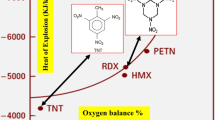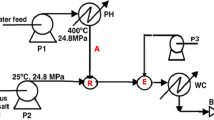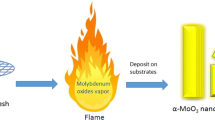Abstract
Surface engineering of energetic particles can offer significant applications; the emergence of surface modification with polydopamine (PDA) can propose novel material science. Even though, nanothermites (metal oxide/metal) can offer surplus heat output; the reaction rate is comparatively-low as it is limited to the interplaner distance between particles. Intimate mixing between metal oxide/metal could be accomplished via surface modification. This study reports on the facile synthesis of MnO2 nanoparticles (NPs) of 5 nm average particle size. On the other hand, Al NPs in the shape of plates of 100 nm particle size were employed. Surface modification of Al NPs with PDA was conducted via in situ polymerization. Colloidal MnO2 NPs integrated into PDA/Al during the polymerization process. DPA layer was effectively-deposited on the aluminium surface and effectively-anchored MnO2 NPs. SEM micrographs of developed MnO2/PDA/Al nanocomposite demonstrated the successful bonding of MnO2 to Al surface via strong PDA chemical bonding. From FTIR spectra, the sharp peaks at 1544 cm−1 and 1389 cm−1 attributed to the C=O and C–O bonds, respectively, and could be due to bond formation between Mn and oxygen in C=O, and C–O in PDA. The developed MnO2/PDA/Al demonstrated the uniform distribution of MnO2 NPs on Al nano-plates. This work dropped the light toward the green production of novel nanothermite hybrid with durable chemical bonding. MnO2/PDA/Al hybrid can offer superior combustion characteristics with intimate mixing between the oxidizer and metal fuel to the molecular level.

Adopted from reference [39]

Adopted from reference [54]

Adopted from reference [54]









Similar content being viewed by others
References
M.A. Elkodous et al., Layer-by-layer preparation and characterization of recyclable nanocomposite (CoxNi1−xFe2O4; X = 0.9/SiO2/TiO2). J. Mater. Sci. 30, 8312–8328 (2019)
M. Abd Elkodous et al., Therapeutic and diagnostic potential of nanomaterials for enhanced biomedical applications. Colloids Surf. B 180, 411–428 (2019)
M.S. Attia et al., Spirulina platensis-polysaccharides promoted green silver nanoparticles production using gamma radiation to suppress the expansion of pear fire blight-producing Erwinia amylovora. J. Clust. Sci. 30, 919 (2019)
A.I. El-Batal et al., Potential nematicidal properties of silver boron nanoparticles: synthesis, characterization, in vitro and in vivo root-knot nematode (Meloidogyne incognita) treatments. J. Clust. Sci. 30(3), 687–705 (2019)
W.F. Khalil et al., Graphene oxide-based nanocomposites (GO-chitosan and GO-EDTA) for outstanding antimicrobial potential against some Candida species and pathogenic bacteria. Int. J. Biol. Macromol. 164, 1370–1383 (2020)
I. Khan, K. Saeed, I. Khan, Nanoparticles: properties, applications and toxicities. Arab. J. Chem. 12, 908–931 (2017)
X. Huang, M.A. El-Sayed, Gold nanoparticles: optical properties and implementations in cancer diagnosis and photothermal therapy. J. Adv. Res. 1(1), 13–28 (2010)
X.-F. Zhang et al., Silver nanoparticles: synthesis, characterization, properties, applications, and therapeutic approaches. Int. J. Mol. Sci. 17(9), 1534 (2016)
J. Valíček et al., Quantifying the mechanical properties of materials and the process of elastic-plastic deformation under external stress on material. Materials (Basel, Switzerland) 8(11), 7401–7422 (2015)
M. Fasano et al., Interplay between hydrophilicity and surface barriers on water transport in zeolite membranes. Nat. Commun. 7, 12762–12762 (2016)
S. Asiya et al., Reliable optoelectronic switchable device implementation by CdS nanowires conjugated bent-core liquid crystal matrix. Org. Electron. 82, 105592 (2020)
K. Pal et al., Cutting edge development on graphene derivatives modified by liquid crystal and CdS/TiO2 hybrid matrix: optoelectronics and biotechnological aspects. Crit. Rev. Solid State Mater. Sci. (2020). https://doi.org/10.1080/10408436.2020.1805295
M. Mousavi-Kamazani, S. Zinatloo-Ajabshir, M. Ghodrati, One-step sonochemical synthesis of Zn(OH)2/ZnV3O8 nanostructures as a potent material in electrochemical hydrogen storage. J. Mater. Sci. 31(20), 17332–17338 (2020)
M. Ghodrati, M. Mousavi-Kamazani, S. Zinatloo-Ajabshir, Zn3V3O8 nanostructures: facile hydrothermal/solvothermal synthesis, characterization, and electrochemical hydrogen storage. Ceram. Int. 46(18), 28894–28902 (2020)
S. Zinatloo-Ajabshir, M. Mousavi-Kamazani, Effect of copper on improving the electrochemical storage of hydrogen in CeO2 nanostructure fabricated by a simple and surfactant-free sonochemical pathway. Ceram. Int. 46(17), 26548–26556 (2020)
S. Zinatloo-Ajabshir et al., Green synthesis, characterization and investigation of the electrochemical hydrogen storage properties of Dy2Ce2O7 nanostructures with fig extract. Int. J. Hydrog. Energy 44(36), 20110–20120 (2019)
M.A. Maksoud et al., Nanostructured Mg substituted Mn-Zn ferrites: a magnetic recyclable catalyst for outstanding photocatalytic and antimicrobial potentials. J. Hazard. Mater. 399, 123000 (2020)
M. Abd Elkodous et al., Carbon-dot-loaded CoxNi1–xFe2O4; x= 0.9/SiO2/TiO2 nanocomposite with enhanced photocatalytic and antimicrobial potential: An engineered nanocomposite for wastewater treatment. Sci. Rep. 10(1), 1–22 (2020)
M. Abd Elkodous et al., Nanocomposite matrix conjugated with carbon nanomaterials for photocatalytic wastewater treatment. J. Hazard. Mater. 124, 124657 (2020)
S.A. Heidari-Asil et al., Amino acid assisted-synthesis and characterization of magnetically retrievable ZnCo2O4–Co3O4 nanostructures as high activity visible-light-driven photocatalyst. Int. J. Hydrog. Energy 45(43), 22761–22774 (2020)
M.I.A.A. Maksoud et al., Antibacterial, antibiofilm, and photocatalytic activities of metals-substituted spinel cobalt ferrite nanoparticles. Microb. Pathog. 127, 144–158 (2019)
M. Abd Elkodous et al., Fabrication of ultra-pure anisotropic zinc oxide nanoparticles via simple and cost-effective route: implications for UTI and EAC medications. Biol. Trace Elem. Res. 196(1), 297–317 (2019)
M. Abd Elkodous et al., Engineered nanomaterials as potential candidates for HIV treatment: between opportunities and challenges. J. Clust. Sci. 30(3), 531–540 (2019)
A.I. El-Batal et al., Gum Arabic polymer-stabilized and Gamma rays-assisted synthesis of bimetallic silver-gold nanoparticles: Powerful antimicrobial and antibiofilm activities against pathogenic microbes isolated from diabetic foot patients. Int. J. Biol. Macromol. 165, 169–186 (2020)
S. Zinatloo-Ajabshir et al., Effect of zirconia on improving NOx reduction efficiency of Nd2Zr2O7 nanostructure fabricated by a new, facile and green sonochemical approach. Ultrason. Sonochem. 71, 105376 (2021)
Y. Wang, Y. Xia, Bottom-up and top-down approaches to the synthesis of monodispersed spherical colloids of low melting-point metals. Nano Lett. 4(10), 2047–2050 (2004)
S. Verma, R. Gokhale, D. Burgess, A comparative study of top-down and bottom-up approaches for the preparation of micro/nanosuspensions. Int. J. Pharmaceut. 380, 216–222 (2009)
M.S. Morassaei, S. Zinatloo-Ajabshir, M. Salavati-Niasari, Simple salt-assisted combustion synthesis of Nd2Sn2O7–SnO2 nanocomposites with different amino acids as fuel: an efficient photocatalyst for the degradation of methyl orange dye. J. Mater. Sci.: Mater. Electron. 27(11), 11698–11706 (2016)
M.S. Morassaei, S. Zinatloo-Ajabshir, M. Salavati-Niasari, New facile synthesis, structural and photocatalytic studies of NdOCl-Nd2Sn2O7-SnO2 nanocomposites. J. Mol. Liq. 220, 902–909 (2016)
S. Zinatloo-Ajabshir, S. Mortazavi-Derazkola, M. Salavati-Niasari, Nd2O3-SiO2 nanocomposites: A simple sonochemical preparation, characterization and photocatalytic activity. Ultrason. Sonochem. 42, 171–182 (2018)
S. Zinatloo-Ajabshir, M.S. Morassaei, M. Salavati-Niasari, Eco-friendly synthesis of Nd2Sn2O7–based nanostructure materials using grape juice as green fuel as photocatalyst for the degradation of erythrosine. Compos. B Eng. 167, 643–653 (2019)
Nie, H.-q., et al., Combustion characteristic and aging behavior of bimetal thermite powders. Defence Technology, 2020.
Elbasuney, S., et al., Super-thermite (Al/Fe2O3) fluorocarbon nanocomposite with stimulated infrared thermal signature via extended primary combustion zones for effective countermeasures of infrared seekers. J. Inorg. Organomet. Polym. Mat. 28, 2231–2240 (2018)
S. Elbasuney, M. Yehia, Ferric Oxide Colloid: A Novel Nano-catalyst for Solid Propellants. J. Inorg. Organomet. Polym Mater. 30(3), 706–713 (2020)
S. Elbasuney et al., Multi-component nanocomposite infrared flare with superior infrared signature via synergism of nanothermite and reduced graphene oxide. J. Mater. Sci.: Mater. Electron. 31(14), 11520–11526 (2020)
S. Elbasuney et al., Novel nanocomposite decoy flare based on super-thermite and graphite particles. J. Mater. Sci.: Mater. Electron. 31(8), 6130–6139 (2020)
Tantawy, H., et al., Synergism of nanothermite and nanophosphrous compound for advanced infrared flares with superior spectral performance. Journal of Energetic Materials, 2020: p. 1–14.
S. Elbasuney et al., Novel High Energy Density Material Based on Metastable Intermolecular Nanocomposite. J. Inorg. Organomet. Polym Mater. 30(10), 3980–3988 (2020)
K.P. Ruggirello et al., A reaction progress variable modeling approach for non-ideal multiphase explosives. Int. J. Multiph. Flow 42, 128–151 (2012)
ZARKO, V.E. and A.A. GROMOV, eds. ENERGETIC NANOMATERIALS Synthesis, Characterization, and Application. 2016, Elsevier: Amsterdam.
D. Spitzer et al., Energetic nano-materials: Opportunities for enhanced performances. J. Phys. Chem. Solids 71(2), 100–108 (2010)
Elbasuney, S. and M. Yehia, Thermal decomposition of ammonium perchlorate catalyzed with CuO nanoparticles. Defence Technology, 2019.
S. Elbasuney, M. Yehia, Thermal decomposition of ammonium perchlorate catalyzed with CuO nanoparticles. Defence Technology 15(6), 868–874 (2019)
Song, J.-x., et al., Thermal and combustion behavior of Al-MnO2 nanothermite with poly(vinylidene fluoride -co- hexafluoropropylene) energetic binder. Defence Technology, 2020.
J. Song et al., A comparative study of thermal kinetics and combustion performance of Al/CuO, Al/Fe2O3 and Al/MnO2 nanothermites. Vacuum 176, 109339 (2020)
W. He et al., Mussel-inspired polydopamine-directed crystal growth of core-shell n-Al@PDA@CuO metastable intermixed composites. Chem. Eng. J. 369, 1093–1101 (2019)
I. You et al., Enhancement of blood compatibility of poly (urethane) substrates by mussel-inspired adhesive heparin coating. Bioconjug. Chem. 22(7), 1264–1269 (2011)
X. Zhang et al., Mussel-inspired fabrication of functional materials and their environmental applications: progress and prospects. Applied Materials Today 7, 222–238 (2017)
J. Jiang et al., Surface characteristics of a self-polymerized dopamine coating deposited on hydrophobic polymer films. Langmuir 27(23), 14180–14187 (2011)
P. Molitor, V. Barron, T. Young, Surface treatment of titanium for adhesive bonding to polymer composites: a review. Int. J. Adhes. Adhes. 21(2), 129–136 (2001)
Y. Fang et al., Polydopamine nanotube for dual bio-inspired strong, tough, and flame retarding composites. Compos. B Eng. 197, 108184 (2020)
S. El Yakhlifi, V. Ball, Polydopamine as a stable and functional nanomaterial. Colloids Surf. B 186, 110719 (2020)
C. Lin et al., Controllable tuning of energetic crystals by bioinspired polydopamine. Energ. Mater. Front. 1, 59–66 (2020)
M.S. Zafar, et al. Polymer science: research advances, practical applications and educational aspects. (2015)
X. Liu et al., Probe into metal-organic framework membranes fabricated via versatile polydopamine-assisted approach onto metal surfaces as anticorrosion coatings. Corros. Sci. 177, 108949 (2020)
H. Luo et al., Facile synthesis of novel size-controlled antibacterial hybrid spheres using silver nanoparticles loaded with poly-dopamine spheres. RSC Adv. 5(18), 13470–13477 (2015)
M. Liu et al., Recent developments in polydopamine: an emerging soft matter for surface modification and biomedical applications. Nanoscale 8(38), 16819–16840 (2016)
S. Chen, Y. Cao, J. Feng, Polydopamine as an efficient and robust platform to functionalize carbon fiber for high-performance polymer composites. ACS Appl. Mater. Interfaces 6(1), 349–356 (2014)
K. Dashtian, S. Hajati, M. Ghaedi, l-Phenylalanine-imprinted polydopamine-coated CdS/CdSe n–n type II heterojunction as an ultrasensitive photoelectrochemical biosensor for the PKU monitoring. Biosens. Bioelectron. 165, 112346 (2020)
Z. Xu, K. Miyazaki, T. Hori, Fabrication of polydopamine-coated superhydrophobic fabrics for oil/water separation and self-cleaning. Appl. Surf. Sci. 370, 243–251 (2016)
N. Bock et al., Polydopamine coating of uncrosslinked chitosan as an acellular scaffold for full thickness skin grafts. Carbohydr. Polym. 245, 116524 (2020)
Y. Chen et al., Reactivity adjustment from the contact extent between CuO and Al phases in nanothermites. Chem. Eng. J. 402, 126288 (2020)
Y. Kim et al., Efficient photocatalytic production of hydrogen by exploiting the polydopamine-semiconductor interface. Appl. Catal. B 280, 119423 (2021)
Y. Chen et al., Mussel-inspired polydopamine coating enhances the intracutaneous drug delivery from nanostructured lipid carriers dependently on a follicular pathway. Mol. Pharm. 17(4), 1215–1225 (2020)
K. Cheng et al., Study on the structure and properties of functionalized fibers with dopamine. Colloids Surf. A 582, 123846 (2019)
M. Liu et al., Self-polymerization of dopamine and polyethyleneimine: novel fluorescent organic nanoprobes for biological imaging applications. J. Mater. Chem. B 3(17), 3476–3482 (2015)
M. Deng et al., High catalytic activity of immobilized laccase on core–shell magnetic nanoparticles by dopamine self-polymerization. J. Mol. Catal. B 112, 15–24 (2015)
J. Wu et al., Functionalization of silk fibroin electrospun scaffolds via BMSC affinity peptide grafting through oxidative self-polymerization of dopamine for bone regeneration. ACS Appl. Mater. Interfaces 11(9), 8878–8895 (2019)
G. Wang, Influence of polydopamine/polylactic acid coating on mechanical properties and cell behavior of 3D-printed calcium silicate scaffolds. Mater. Lett. 275, 128131 (2020)
S. Elbasuney, Novel colloidal nanothermite particles (MnO2/Al) for advanced highly energetic systems. J. Inorg. Organomet. Polym Mater. 28(5), 1793–1800 (2018)
M.A. Elsayed, M. Gobara, S. Elbasuney, Instant synthesis of bespoke nanoscopic photocatalysts with enhanced surface area and photocatalytic activity for wastewater treatment. J. Photochem. Photobiol. A 344, 121–133 (2017)
A.M. El-Khawaga et al., Promising antimicrobial and azo dye removal activities of citric acid-functionalized magnesium ferrite nanoparticles. J. Clust. Sci. (2021). https://doi.org/10.1007/s10876-020-01944-y
S. Elbasuney et al., Ferric oxide colloid: novel nanocatalyst for heterocyclic nitramines. J. Mater. Sci. 32, 4185–4195 (2021)
X.-D. Lin et al., Synthesis of ultrathin and compact Au@MnO2 nanoparticles for shell-isolated nanoparticle-enhanced Raman spectroscopy (SHINERS). J. Raman Spectrosc. 43(1), 40–45 (2012)
S. Elbasuney et al., Novel (MnO2/Al) thermite colloid: an opportunity for energetic systems with enhanced performance. J. Mater. Sci. 31(23), 21399–21407 (2020)
S. Elbasuney, Dispersion characteristics of dry and colloidal nano-titania into epoxy resin. Powder Technol. 268, 158–164 (2014)
S. Elbasuney, Continuous hydrothermal synthesis of AlO(OH) nanorods as a clean flame retardant agent. Particuology 22, 66–71 (2015)
S. Elbasuney, Surface engineering of layered double hydroxide (LDH) nanoparticles for polymer flame retardancy. Powder Technol. 277, 63–73 (2015)
S. Elbasuney, Sustainable steric stabilization of colloidal titania nanoparticles. Appl. Surf. Sci. 409, 438–447 (2017)
M.A. Maksoud et al., Synthesis and characterization of metals-substituted cobalt ferrite [MxCo(1–x)Fe2O4;(M = Zn, Cu and Mn; x = 0 and 0.5)] nanoparticles as antimicrobial agents and sensors for Anagrelide determination in biological samples. Mater. Sci. Eng. C 92, 644–656 (2018)
A. Ashour et al., Antimicrobial activity of metal-substituted cobalt ferrite nanoparticles synthesized by sol–gel technique. Particuology 40, 141–151 (2018)
M.A. Maksoud et al., Tunable structures of copper substituted cobalt nanoferrites with prospective electrical and magnetic applications. J. Mater. Sci. 30, 1–12 (2019)
R.J. Gohari et al., Improving performance and antifouling capability of PES UF membranes via blending with highly hydrophilic hydrous manganese dioxide nanoparticles. Desalination 335(1), 87–95 (2014)
J.-G. Wang et al., Incorporation of nanostructured manganese dioxide into carbon nanofibers and its electrochemical performance. Mater. Lett. 72, 18–21 (2012)
B.G.S. Raj et al., Sonochemically synthesized MnO2 nanoparticles as electrode material for supercapacitors. Ultrason. Sonochem. 21(6), 1933–1938 (2014)
S. Zhu et al., Synthesis of MnO2 nanoparticles confined in ordered mesoporous carbon using a sonochemical method. Adv. Func. Mater. 15(3), 381–386 (2005)
H. Gao et al., The efficient biogeneration of Ag and NiO nanoparticles from VPLE and a study of the anti-diabetic properties of the extract. RSC Adv. 10(5), 3005–3012 (2020)
S. Moshtaghi, S. Zinatloo-Ajabshir, M. Salavati-Niasari, Preparation and characterization of BaSnO3 nanostructures via a new simple surfactant-free route. J. Mater. Sci. 27(1), 425–435 (2016)
S. Zinatloo-Ajabshir et al., Nd2Sn2O7 nanostructures: green synthesis and characterization using date palm extract, a potential electrochemical hydrogen storage material. Ceram. Int. 46(11), 17186–17196 (2020)
C. Mandilas et al., Synthesis of aluminium nanoparticles by arc plasma spray under atmospheric pressure. Mater. Sci. Eng. B 178(1), 22–30 (2013)
M. Paskevicius et al., Mechanochemical synthesis of aluminium nanoparticles and their deuterium sorption properties to 2 kbar. J. Alloy. Compd. 481(1–2), 595–599 (2009)
B. Alinejad, K. Mahmoodi, A novel method for generating hydrogen by hydrolysis of highly activated aluminum nanoparticles in pure water. Int. J. Hydrogen Energy 34(19), 7934–7938 (2009)
M. Paskevicius et al., Mechanochemical synthesis of aluminium nanoparticles and their deuterium sorption properties to 2kbar. J. Alloy. Compd. 481(1), 595–599 (2009)
A.I. El-Batal et al., Penicillium chrysogenum-mediated mycogenic synthesis of copper oxide nanoparticles using gamma rays for in vitro antimicrobial activity against some plant pathogens. J. Clust. Sci. 31(1), 79–90 (2020)
G.S. El-Sayyad et al., Gentamicin-assisted mycogenic selenium nanoparticles synthesized under gamma irradiation for robust reluctance of resistant urinary tract infection-causing pathogens. Biol. Trace Elem. Res. 195(1), 323–342 (2020)
S. Elbasuney et al., Reduced graphene oxide: a novel black body emitter for advanced infrared decoy flares. J. Energ. Mater. 39(1), 100–112 (2020). https://doi.org/10.1080/07370652.2020.1762800
S. Elbasuney et al., Infrared signature of novel super-thermite (Fe2O3/Mg) fluorocarbon nanocomposite for effective countermeasures of infrared seekers. J. Inorg. Organomet. Polym Mater. 28(5), 1718–1727 (2018)
S. Elbasuney et al., Infrared spectra of customized magnesium/teflon/viton decoy flares. Combust. Explos. Shock Waves 55(5), 599–605 (2019)
Author information
Authors and Affiliations
Corresponding authors
Ethics declarations
Conflict of interest
The authors declare that they have no conflict of interest.
Additional information
Publisher's Note
Springer Nature remains neutral with regard to jurisdictional claims in published maps and institutional affiliations.
Supplementary Information
Below is the link to the electronic supplementary material.
Rights and permissions
About this article
Cite this article
Elbasuney, S., Yehia, M. & El-Sayyad, G.S. Bio-inspired metastable intermolecular nanothermite composite based on Manganese dioxide/Polydopamine/Aluminium. J Mater Sci: Mater Electron 32, 9158–9170 (2021). https://doi.org/10.1007/s10854-021-05582-6
Received:
Accepted:
Published:
Issue Date:
DOI: https://doi.org/10.1007/s10854-021-05582-6





